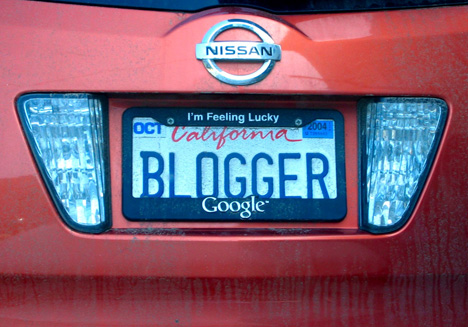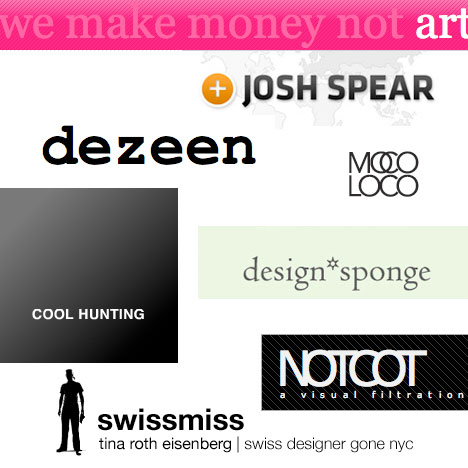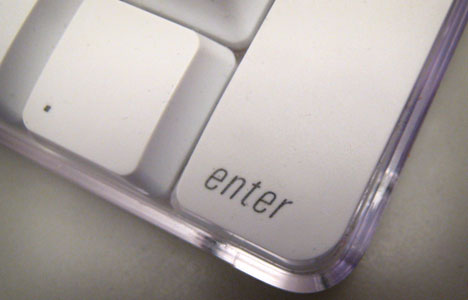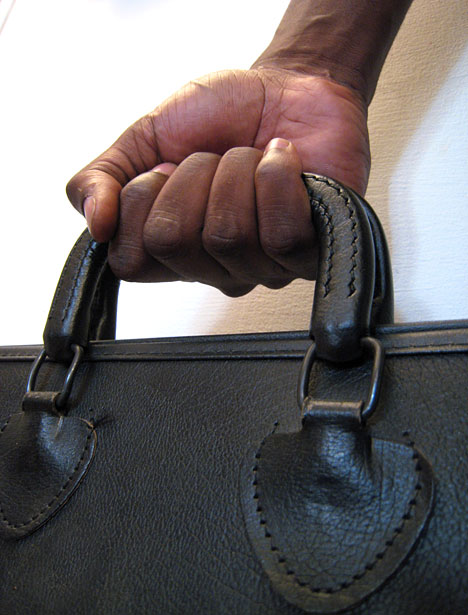








Today's ready-to-use and free online tools like blogs and photo and video sharing sites make presentation boards and booklets nearly futile...and your clumsy roomate's orange soda won't stain in cyberspace. Whether you're sharing a hot new concept or just some good ol' classroom antics, tell your story proper and show every nitty-gritty detail in a well documented blog. Set something up in no time using Square Space, Blogger, Wordpress, or Tumblr to document the research, process, and final outcome of independent, group, and class projects. Archive photos and set up handy slideshow presentations using Flickr and mesmerize the masses by sharing ID-centric videos on Youtube or Vimeo. The best part is you can embed it all back in your blog. Divulge. Upload. Get to it!

"Dear Core"? "Dear Core Editor"? "Hey Core, I love you and I'm wondering if you'll publish my..."? What are the Do's and Don't's of sending your stuff in to design blogs? We asked the editors of 8 top design blogs for their advice. Most common advice?: No PDFs, and send a thank you note if they publish you. Here are some highlights from each editor. Read the full text of their sage advice here.

Right up there with going to class, doing your homework and changing your underwear at least every other day, networking is a skill that's absolutely critical to your budding career. Networking is the only way for people to associate a personality with your portfolio. It completes your brand experience, if you will. And in your case, it can make the difference between getting blown off and getting a job. Any wanna-be designers with visions of health insurance dancing in their heads would be crazy not to indulge in a little extracurricular mingling with others in the field. Besides—and this is good news for you—the drinks are usually free.
During the upcoming school year many of your peers will attempt to navigate the legendary social circles of their elders. The best of them will get a flurry of Linked In hits, a phone call or two, and possibly something we working folk like to call employment. The worst of them? Well, you've already seen them humping the podium after one too many Jagermeister and Red Bulls, tossing business cards at Yves Béhar while mumbling something inappropriate about his hair.
I'm not saying it's more important to go to the IDEO panel downtown than do your color study homework...but sometimes it's more important to go to the IDEO panel downtown.
If you already did that last week, don't worry—at least everyone will remember you. But if you'd prefer to network like a pro, follow these five simple rules. Soon you'll be the most popular employed designer in town.
Continue reading The Life of the Party: Working Your Net by Alissa Walker.

There's nothing duller than looking at a student portfolio with nothing in it other than "student work." So how do you change it up? Well, enter a bunch of design competitions while you're in school, and you'll have a more varied mix. But that's not all. Here are 5 reasons why you should be entering design competitions while you're still a student:

Rover applied for a job at a well-known consulting firm in NYC. His buddy Greg, whose face is cut off in this picture, was being considered for the exact same position. Who acquired the job after all?
Greg.
Despite Rover's excellent sketching skills, future-forward thinking, and awesome model-making technique, he overlooked the fragility of his presence in public 2.0.
Everyone likes to party, but it's best to leave the party at the party. You must remember that your profiles on networking sites like Facebook, LinkedIn, and Instagram are a reflection of who you are and are oftentimes accessible to strangers—this includes prospective employers. DIY background checks are easier than ever to execute, so it's an excellent idea to polish up your online presence.
Don't take the easy way out by setting everything to private. Take advantage of these opportunities to show your best attributes. (Don't worry, your friends still know you're a beer-guzzling booze hound on the weekends—you don't need to advertise it.) Be selective of who you accept as friends and think hard before you post. Let the world know what you've accomplished and what inspires you, exposing positive and likeable elements of your personal and professional self.

Yes. Google yourself. Potential employers won't hesitate to Google you. Be aware of same-namers you don't want to be confused with. Make mention of unsavory search results having nothing to do with you.
While you're at it, feel free to add some profesh flair to your online comms. Set up a professional email address and screen name. catbutt87@hotmail.com is completely unacceptable and we can guarantee that professionals won't take chats with beer4me4ever seriously. When in doubt, use your real name or a slight variation.

For some of you, the very decision to study design stems from a dislike for, or at least ambivalence toward, writing. And yet, more and more design programs are requiring that students write essays and theses as part of humanities or liberal arts classes—classes that in the end can account for up to a third of a student's credits. Some students are finding, to their surprise, that when it's directed toward something they are really interested in—themselves and their work, for example, or the world seen through a design-tinted lens—they are actually pretty good at writing after all.
Some students are finding, to their surprise, that when it's directed toward something they are really interested in—themselves and their work, for example, or the world seen through a design-tinted lens—they are actually pretty good at writing after all.
The designer who writes is hardly a new phenomenon, however. The tradition extends all the way back to design's emergence as a discipline. In Carma Gorman's anthology of writings about industrial design, which spans the years 1851 to 1999, none of the extracts featured are by writers who make their living by writing alone. Some of the pieces are by politicians such as Nixon and Krushchev, or manufacturers such as Henry Ford, but most by far are authored by designers. From Christopher Dresser and William Morris in the late 19th century to Le Corbusier, Eliot Noyes, Dieter Rams and Charles Jencks in the 20th, these designers expressed opinions and theories about their own work and their profession through the medium of writing.
Today, the vehicles for design writing and criticism are more abundant than ever before. As blogs, magazines, academic journals and newspaper column inches devoted to design proliferate, so do the numbers of designers who consider writing a key component of their toolsets. In addition to these publishing venues, there are other initiatives that aim to improve the quality of design writing and enrich design discourse. Among them are a new clutch of graduate programs in design writing and criticism in the US, Sweden and London.
As designers you can use writing in a multitude of ways. Here are just three:
Continue reading Design Writing in Three Flavors by Alice Twemlow.

Most design students start putting their portfolios together at the end of their education—indeed, most schools offer their "portfolio class" during the final semester. Bad idea. What you should do instead is start your portfolio the first semester of your design education. Here're 2 whys and 2 hows:

There are many places online to put your design work, but we want you bad. Coroflot is an amazing place to find creative work (the "creative output" kind as well as the "creative paycheck" kind), and with tens of thousands of portfolios and hundreds of design jobs, you're sure to find what you're looking for...and be found.